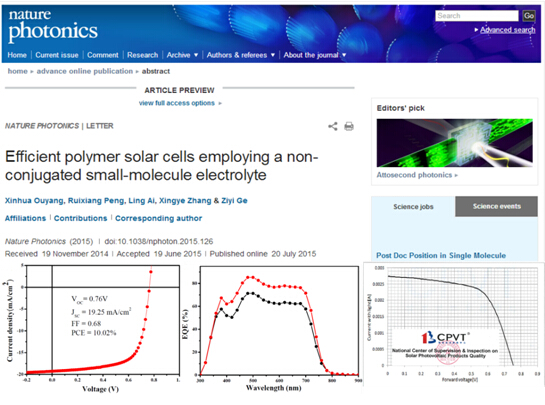Polymer solar cells have attracted a lot of attention due to the attractiveness of their use in renewable energy sources that are potentially light weight and low in cost. Numerous significant research efforts have resulted in polymer solar cells with enhanced power conversion efficiencies. Nevertheless, further improvements in performance are sought for commercial applications. Interface engineering is crucial to promote the performance of organic photovoltaic devices due to the abilities to optimize the absorption, distribute the optical field, and enhance the transport of carries. The study and development of new interfacial materials with desired charge selectivity for all-solution-processed multilayer devices, and compatibility in proper integration of the interfacial layer with different active materials are important for further improvement of the efficiency and stability.
In a recent Nature Photonics publication with the title of "efficient polymer solar cells employing a non-conjugated small-molecule electrolyte" (Nature Photonics, 2015, DOI:10.1038/nphoton.2015.126), Prof. ZiyiGe from Ningbo Institute of Materials Technology and Engineering, Chinese Academy of Sciences compounded an easily prepared, low cost and solution-processed non-conjugated organic small-molecule electrolyte as cathode interfacial layer to effectively improve the electron transfer and collection abilities.The Non-conjugated small-molecule electrolyte was used to replace the traditionally vacuum-deposited metals and their salts (Ca, Mg, LiF, CsF, Cs2CO3etc) or these organic π-conjugated ones with complicated synthesis. By using the non-conjugated organic small-molecule electrolyte as an interlayer of optimal polymer solar cells, the power conversion efficiency can be enhanced to be 10.02%, which was a breakthroughfor single junction polymer solar cells. Furthermore, the present results were also certified by the National Center of Supervision & Inspection on Solar Photovoltaic Products Quality (CPVT), which was among the highest efficiencies of reported and certified single-junction polymer solar cells. In the meanwhile, the reviewer from Nature Photonics thought “the work was well presented and provide a significant contribution to the field”. The results suggested a promising interface strategy for high-efficiency and large area polymer solar cells.

Prof.Ziyi Ge: geziyi@nimte
Research Staff Url:
http://english.nimte.cas.cn/rh/rd/newenergy/op/op_research_interests/
All Images by ![]()

